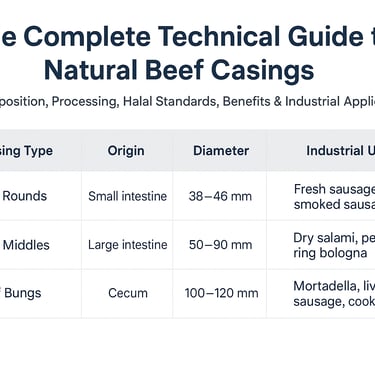"Aquab Casing Delivers with Flexible Payment Options (DA & COD) – DAP and Door-to-Door Worldwide!"
The Complete Technical Guide to Natural Beef Casings: Composition, Processing, Safety & Industrial Applications
A professional technical guide explaining what beef casings are, how they’re made, their safety, edible collagen casings, industrial applications, and casing types used in sausages.
Beef Casing
11/23/20253 min read


The Complete Technical Guide to Natural Beef Casings: Composition, Processing, Halal Standards & Industrial Applications
Natural beef casings are an essential raw material in the global sausage-manufacturing industry. Their strength, durability, and ability to handle large filling volumes make them the preferred choice for products such as ring bologna, mortadella, dry salami, pepperoni, cooked sausages, halal meat products, and specialty deli items.
This guide provides an in-depth, technical explanation of what beef casings are, how they’re produced, their classifications, halal considerations, quality standards, sizes, storage requirements, regulatory compliance, and how they compare to collagen, hog, and cellulose casings.
1. What Are Natural Beef Casings?
Natural beef casings are the cleaned and processed intestines of cattle, primarily taken from the beef middle (large intestine), the beef rounds (small intestines), and the beef bungs (cecum). Each type serves a different industrial purpose due to its diameter, strength, and texture.
Types of Beef Casings
Casing Type Origin Diameter Industrial Use Beef Rounds Small intestine 38–46 mm Fresh sausage, smoked sausage Beef Middles Large intestine 50–90 mm Dry salami, pepperoni, ring bologna Beef Bungs Cecum 100–120 mm Mortadella, liver sausage, cooked meats
Beef casings are known for their:
High strength and resistance
Ability to withstand long fermenting or drying processes
Excellent smoke penetration
Natural bite and authentic texture
2. Are Beef Casings Edible?
Yes — natural beef casings are fully edible, as long as they are properly cleaned and processed according to international food-safety standards.
However, some larger beef middles may become tougher after long drying periods and are sometimes removed before eating, depending on regional preferences.
3. Are Beef Casings Halal?
Beef casings are halal only when the cattle are slaughtered according to Islamic law. For a casing to be certified halal:
Halal Requirements
Animal must be slaughtered by a Muslim
Tasmiyah (invocation) must be recited
No contact with non-halal equipment
No cross-contamination with pork products
Salt-curing agents must be halal-certified
Halal-Sensitive Points
Many factories reject beef casings from mixed plants because:
Equipment may be previously used for hog casings
Storage rooms may not be segregated
Workers may handle pork in parallel lines
Certified halal beef casings require:
Independent halal audit
Batch-wise certification
Traceability from slaughterhouse to export
4. Are Beef Casings Safe to Eat?
Yes. Natural beef casings are considered safe by:
FDA
USDA
EU Food Safety Authority
Pakistan Halal Authority
GCC / Middle East halal bodies
They are a natural, non-chemical casing alternative compared to collagen or artificial cellulose casings.
5. What Are Beef Casings Made Of?
Beef casings are primarily composed of:
Collagen (Type I & III)
Elastin fibers
Water-binding proteins
Connective tissues
This natural structure is what gives beef casings:
Superior elasticity
Strength during stuffing
A natural, authentic texture
6. How Are Beef Casings Processed?
Processing steps follow strict hygienic procedures.
Step-by-Step Production Process
Harvesting at Slaughterhouse
Intestines are removed immediately after slaughter.Stripping & Removal of Contents
Using soft mechanical tools, the internal mass is removed.Flushing and Cleaning
High-pressure cold-water cleaning removes impurities.Turning & Mucosa Removal
The intestine is turned inside out; mucosa is scraped away.Salting (Preservation Stage)
Casings are packed in:Dry salt
Brine solution (18–25% salt)
Sizing & Calibration
Casings are grouped into size ranges (mm).Quality Grading
A Grade – best texture, uniform diameter
AB Mix – industry-standard export mix
B Grade – economic option
Packing
Packed in barrels, bags, or vacuum-sealed blocks.
7. What Size Do Beef Casings Come In?
Typical diameter ranges:
Beef Rounds
38–46 mm
Beef Middles
50–90 mm
Beef Bungs
100–120 mm
Uniformity is essential for industrial filling machines.
8. What Are Beef Casings Used For?
Beef casings are used for large-diameter sausages and specialty deli meats.
Industrial Applications
Salami
Pepperoni
Ring bologna
Cooked beef sausage
Mortadella
Liver sausage
Halal deli meats
Specialty fermented products
Beef casings are ideal for dry-cured sausages due to their ability to handle long aging times.
9. Do Beef Casings Need to Be Soaked?
Yes — before use, casings must be soaked 8–24 hours in fresh water.
Soaking Process
Rinse off excess salt
Soak in cold water for 2 hours
Transfer to warm water (35–40°C) before stuffing
This restores flexibility and prevents breakage.
10. How Long Do Beef Casings Last?
Shelf life depends on storage conditions:
Salted Casings
1–2 years shelf life
Stored at 4–10°C
Dry-salted Casings
18–36 months
Avoid freezing — it damages fibers.
11. Storage & Handling
To maintain quality:
Store at cool temperatures
Keep casings submerged in salt
Avoid direct sunlight
Keep sealed to prevent dehydration
Cross-contamination with pork casings must be avoided in halal supply chains.
12. Are Beef Casings Better Than Collagen?
Advantages
Natural, authentic bite
Better strength
Excellent smoke absorption
More suitable for fermented meats
Disadvantages
More expensive
Requires expertise to handle
Diameter variation
For premium salami and halal industries, beef casings are preferred.
13. Beef Casings vs. Hog Casings
Feature Beef Casings Hog Casings Diameter Larger Smaller Strength Higher Medium Texture Firmer Softer Halal Status Halal possible Not halal
14. Advantages of Natural Beef Casings
Natural permeability
High durability during stuffing
Better flavor absorption
Longer fermentation resistance
100% edible & natural product
Improves premium sausage quality
15. Disadvantages
Higher price
Requires soaking and preparation
Natural variation in size
Tougher texture in some applications
16. Are Beef Casings Environmentally Friendly?
Yes. Beef casings are:
Biodegradable
Originating from by-product utilization
Zero-waste certified in many plants
This makes them more sustainable than cellulose or plastic casings.
17. Who Uses Beef Casings?
Sausage factories
Halal meat processors
Delicatessen manufacturers
Export-oriented meat plants
Dry-cured sausage producers
Industrial smokehouses
18. Global Export Markets for Beef Casings
Major buyers include:
Italy
Germany
USA
Middle East & GCC
Turkey
Malaysia
Indonesia
Halal markets prefer beef casings from Pakistan, Turkey, and Middle East.
you may order us from Aquab Casing
info@aquabcasing.com
+923057608848
88/51C , Street 15 Usmanabad, Multan Pakistan
All Right Reserved by Aquab Casing @ 2023
Contact Us!
